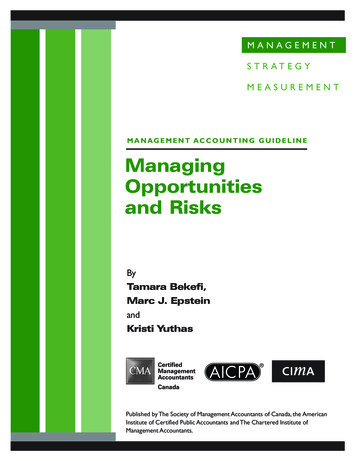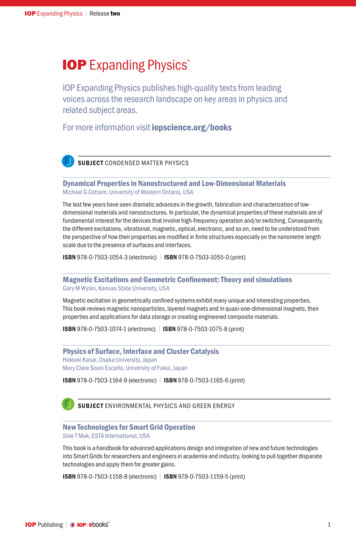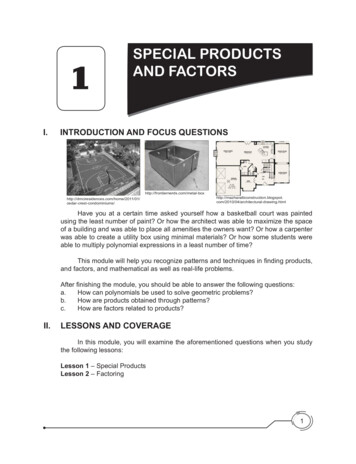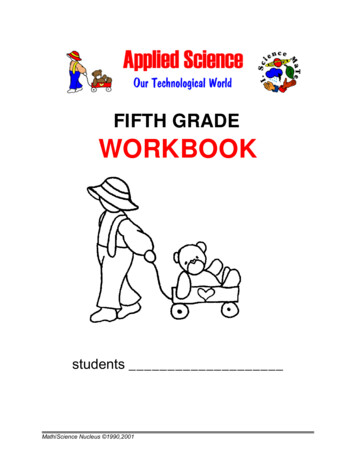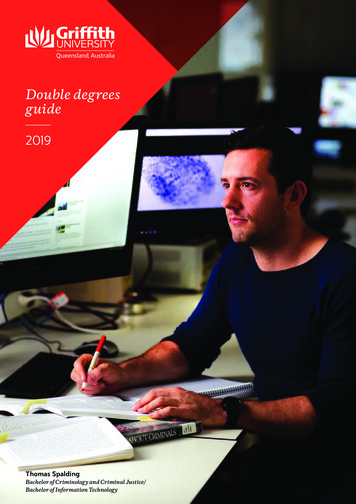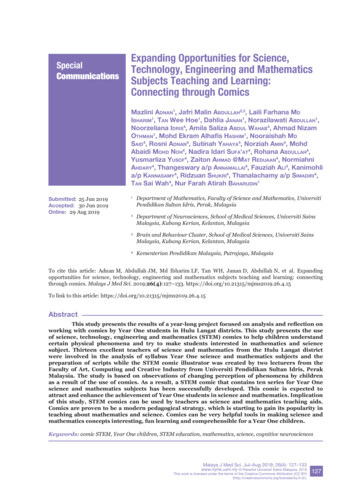
Transcription
SpecialCommunicationsExpanding Opportunities for Science,Technology, Engineering and MathematicsSubjects Teaching and Learning:Connecting through ComicsMazlini Adnan1, Jafri Malin Abdullah2,3, Laili Farhana MdIbharim1, Tan Wee Hoe1, Dahlia Janan1, Norazilawati Abdullah1,Noorzeliana Idris4, Amila Saliza Abdul Wahab4, Ahmad NizamOthman1, Mohd Ekram Alhafis Hashim1, Nooraishah MdSaid4, Rosni Adnan4, Sutinah Yahaya4, Norziah Amin4, MohdAbaidi Mohd Noh4, Nadira Idari Sufa'at4, Rohana Abdullah4,Yusmarliza Yusof4, Zaiton Ahmad @Mat Reduaan4, NormiahniAhdary4, Thangeswary a/p Annamallai4, Fauziah Ali4, Kanimohlia/p Kannasamy4, Ridzuan Shukri4, Thanalachamy a/p Simadiri4,Tan Sai Wah4, Nur Farah Atirah Baharudin1Submitted: 25 Jun 2019Accepted: 30 Jun 2019Online: 29 Aug 20191Department of Mathematics, Faculty of Science and Mathematics, UniversitiPendidikan Sultan Idris, Perak, Malaysia2Department of Neurosciences, School of Medical Sciences, Universiti SainsMalaysia, Kubang Kerian, Kelantan, Malaysia3Brain and Behaviour Cluster, School of Medical Sciences, Universiti SainsMalaysia, Kubang Kerian, Kelantan, Malaysia4Kementerian Pendidikan Malaysia, Putrajaya, MalaysiaTo cite this article: Adnan M, Abdullah JM, Md Ibharim LF, Tan WH, Janan D, Abdullah N, et al. Expandingopportunities for science, technology, engineering and mathematics subjects teaching and learning: connectingthrough comics. Malays J Med Sci. 2019;26(4):127–133. https://doi.org/10.21315/mjms2019.26.4.15To link to this article: his study presents the results of a year-long project focused on analysis and reflection onworking with comics by Year One students in Hulu Langat districts. This study presents the useof science, technology, engineering and mathematics (STEM) comics to help children understandcertain physical phenomena and try to make students interested in mathematics and sciencesubject. Thirteen excellent teachers of science and mathematics from the Hulu Langat districtwere involved in the analysis of syllabus Year One science and mathematics subjects and thepreparation of scripts while the STEM comic illustrator was created by two lecturers from theFaculty of Art, Computing and Creative Industry from Universiti Pendidikan Sultan Idris, PerakMalaysia. The study is based on observations of changing perception of phenomena by childrenas a result of the use of comics. As a result, a STEM comic that contains ten series for Year Onescience and mathematics subjects has been successfully developed. This comic is expected toattract and enhance the achievement of Year One students in science and mathematics. Implicationof this study, STEM comics can be used by teachers as science and mathematics teaching aids.Comics are proven to be a modern pedagogical strategy, which is starting to gain its popularity inteaching about mathematics and science. Comics can be very helpful tools in making science andmathematics concepts interesting, fun learning and comprehensible for a Year One children.Keywords: comic STEM, Year One children, STEM education, mathematics, science, cognitive neurosciencesMalays J Med Sci. Jul–Aug 2019; 26(4): 127–133www.mjms.usm.my Penerbit Universiti Sains Malaysia, 2019This work is licensed under the terms of the Creative Commons Attribution (CC 27
Malays J Med Sci. Jul–Aug 2019; 26(4): 127–133IntroductionSTEM ComicsThe word ‘comic’ comes from the Greekword ‘kōmōidía’ or ‘comedy’. Comics use pictureswith words that are often combined with humourand can be found in a variety of contexts, suchas newspapers. Though similar types of artisticapproaches could include cartoons which usuallyinvolve drafts or animation, or graphic novelsand a much more detailed story of episode.The research focus on using comics asa pedagogical tool for teaching and learningdates back to the 1940s and mostly focusedon emerging literacy (1, 2). Incorporatingtexts with visual representations whileteaching young children to read contributed toincreasing children’s attention due to noveltyand incongruity, more elaborate retrievalstrategies and positive emotions are associatedwith learning (1, 4, 5). McVicker (4) stated that,cartoons can be used to enhance and supportthe learning that goes on in any classroom inversatile and creative ways.Although there are few experimentalresearch designs in education, (6) and (7)had documented positive student learninggains when humour is used effectively in thecourse of instruction. Nagata (8) found thatusing manga (Japanese comics and cartoons)helped students in biochemistry ‘use additionalinformation and provide cognitive-psychologicaland pedagogical-technical effects: They givestudents clues to remember what they havelearnt and make biochemistry lectures exciting’(p. 203). Martin (5) stated that “humour servesas a sort of mnemonic technique or memory aid,causing greater elaboration of information andtherefore enhancing its transfer and storage inlong-term memory” (p. 104). Through humourand pictures, comics can illustrate key pointsand ‘lighten’ the classroom setting. This type ofdual processing, emotional (humour) and visual(pictures/text), can help level the playing fieldfor students trying to accommodate abstractcontent. Martin (5) noted that humour shouldbe directly related to the content and studentlearning, not just merely for entertainment.Selectivity of the stimuli is important withattention devoted to novelty, incongruity andsurprise, while refraining from sarcasm andcrassness (9).When students are faced with learningabstract contents, creating meaningful teachingand learning opportunities is a challenge formany educators. Thus, STEM comics havebeen developed as one of the steps to producemeaningful teaching aids. STEM comics is aspecial comic for Year One students integratingscience and mathematics into one comic. Thiscomic is derived from a study which grantsgiven by the Educational Planning and ResearchDivision (EPRD) division. The title of the studywas ‘STEM comics construction and testing onthe achievement of science, mathematics andhigher order thinking skills (HOTS) among YearOne school students in Hulu Langat district,Selangor’.The STEM comics construction phaseuses the TPACK model as shown in Figure 1beginning with the preparation of knowledgeand pedagogical content involving thirteenoutstandingHuluLangatscienceandmathematics teachers. Four topics for sciencesubjects and five topics for second-termmathematics are selected from the Curriculumand Assessment Standard Document (DSKP),Primary School Standard Curriculum (KSSR) asshown in Table 1.The constructive alignment of the contentof knowledge and pedagogy between science andmathematics subjects is first implemented beforethe mapping of the comic storyline is done.In this comic, there are five main characters:Professor Megat Adam (neuro-gardener sifoo),Megat Amir (neuron man), Princess Hanna(neuron woman), Megat Alif (neuron boy) andPrincess Sarah (neuron girl). From technologicalaspects, the STEM comics illustration istranslated in the form of comics as a result ofthe storyline. Illustrators consisting of lecturersand UPSI students use Adobe Photoshop andAdobe Illustrator software. The STEM comics gothrough the process of revising the appropriatelanguage and graphics aspect according to theMinistry of Education (MOE) standards.There are ten series in comics include aseries of introduction. Each has its own theme.The following themes are included for each serieswhich are Introduction, Series 1–Playground,Series 2–Happy Birthday Sarah, Series 3–MonthCommittee of Science And Mathematics, Series4–The Rain Oh Rain, Series 5–Sports, Series6–Rotten, Series 7–Vegetable Project, Series8–Going Back to Hometown, Series 9–Picnic inPort Dickson.128www.mjms.usm.my
Special Communications Opportunities STEM comics expanding the cognitive mindMethodologyFigure 1. Model of knowledge technology,pedagogy and content (10)The STEM comics were conducted ateleven primary schools in the district of HuluLangat namely Sekolah Kebangsaan Kajang,Sekolah Kebangsaan Kajang Utama, SekolahKebangsaan Sri Jerlok, Sekolah KebangsaanSemenyih, Sekolah Kebangsaan Kg Rinching,Sekolah Kebangsaan Bandar Seri Putera,Sekolah Kebangsaan Bangi, Sekolah KebangsaanTasek Permai, Sekolah Kebangsaan PandanJaya, Sekolah Kebangsaan Tun Hussien Onn2 and Sekolah Kebangsaan Batu 9. A total of307 students were selected from a class thatdid not conduct teaching and learning in dualprogrammes. Additionally, selected studentsalso have no learning and reading problems. Theselection of the sample was using a randomisedstratified method of two schools selected fromeach zone in the district of Hulu Langat.Table 1. Topics in science and mathematics and series matchedScienceSeriesMathematicSeriesConstruction of base shapeSeries 1, 2 and 3SpaceSeries 1AbsorptionSeries 4, 5 and 6Day and month, face of the clockSeries 2LandSeries 7 and 8Data managementSeries 3The face of the earthSeries 9Size measureTwo-dimensionalSeries 4, 5, 6, 7Series 9Figure 2. Main characters of STEM comicswww.mjms.usm.my129
Malays J Med Sci. Jul–Aug 2019; 26(4): 127–133The comic sessions by science andmathematics teachers were carried out fora week and the comic test was implementedafter that period. Comic test sessions areconducted in the classroom with the help ofteachers and researchers using the Single-GroupPost Test Only Quasi-Experiment method.Instruments used during the test session wereInventory Measurement of Interest in Scienceand Mathematics, Usability MeasurementInventory, Science Achievement t. After data is collected, the data isanalysed using descriptive statistics (mod andmedian) to determine the interests, usabilityand achievement of students' science andmathematics after using STEM comics.Climax:naughty boy fell off the sliderConflict agent–Intentional kidnapperIntroduce charactersand situations: Boy & girl PlaygroundIntro 3Conflict ofmischief plays inthe wrong wayMid 5Ending story: neuronboy & girl are advisedand inform aboutEnd 4Figure 3. Log line: neuron boy and girl–playground–conflicts of naughty boy misuse the game toolsFigure 4. Front cover and series of STEM comics130www.mjms.usm.my
Special Communications Opportunities STEM comics expanding the cognitive mindFigure 5. The implementaion of STEM comics during teaching and learning sessionResults and DiscussionUsability of ComicsComics can be used to establish a positiveaffective context and interest in the theories ofteaching and learning, and encourage studentsto continue to reflect and think critically on thebest practices for learning and engagement.A heightened sense of enjoyment in the classand the appreciation for teachers who usehumours in the classroom have been found inexperimental studies (10).The usability value of comics is based onfive sub-constructs that are controls, readersatisfaction, accessibility, reader efficiency andlearning. It is found that four out of five subconstructs show a high mean value of eadership efficiency (2.52) and learning (2.74).Overall, the Year One students agreed that STEMcomics could be used in science and mathematicsas teaching aids.Interest in Comics, Science andMathematicsConclusionThe result shows that an interest in comicswas high with a mean value of 2.63, whileinterest in science and mathematics, respectively,is 2.65 and 2.63. This shows that, as a whole,most of Year One pupils are interested in comicsreading. Additionally, they also agree that STEMcomics can attract students to learn science andmathematics.This paper highlights on how to usecomics to illustrate educational psychologicalconcepts and promote student learning. Becausehumourous illustrations and situations are oftenassociated with positive emotions, educatorshave acknowledged the beneficial effects ofsuch devices (5). Using alternative methods,such as humours or comics to guide studentsin constructing knowledge, creates a richerwww.mjms.usm.my131
Malays J Med Sci. Jul–Aug 2019; 26(4): 127–133understanding of concepts that can be appliedinto actual learning settings. It can also enhanceattention and help with retrieval strategies. Byencouraging innovative methods in teaching,educators can move theory from an intellectualexercise to a pedagogical tool for critical thinkingand instructional decision making.The findings of the study shows that thecomics developed are objective and can beimplemented well. In addition, it is found that allseries of comics produced can be implementedand appropriate to the target group. Thismeans that all the series and themes found inthe resulting STEM comics are at a good andsatisfactory level. Next, they also agree thatSTEM comics can attract students to learnscience and mathematics. Based on the findingsof the achievement test, STEM comics can helpstudents in improving the achievement of scienceand mathematics. It is hoped that this STEMcomics can be used as a meaningful material forYear One students so that it can help increasestudents’ interest and achievement in scienceand mathematics.AcknowledgementsWe extend our gratitude to EducationalPlanning and Research Division (EPRD),Ministry of Education Malaysia (KPM) forproviding the funds (Research Grant Code: 20180004-107-52) and giving the official approvalthat enabled us to conduct the research. Specialthanks to the science and mathematics teachersfrom primary schools in Hulu Langat district,Selangor, Malaysia for their involvement in thisresearch.Conflict of InterestAuthors’ ContributionsConception and design: MA, JMA, LFMI, DJ, TWH,ASAW, EAH, ANOAnalysis and interpretation of the data: MA, JMA,LFMI, DJ, TWH, NA, ASAWDrafting of the article: MA, JMA, LFMICritical revision of the article for important intellectualcontent: JMA, LFMIFinal approval of the article: JMAProvision of study materials or patients: MA, JMA,LFMI, DJ, TWH, NA, NI, ASAW, FAB, TA, FA, KK, RS,TS, TSW, NMS, RA, SY, NA, MAMN, NIS, RAB, YY,ZAMR, NAHStatistical expertise: MAObtaining of funding: MA, JMA, LFMI, DJ, TWH, NA,ASAWAdministrative, technical or logistic support: MA,JMA, LFMI, DJ, TWH, NA, NI, ASAW, FAB, TA, FA,KK, RS, TS, TSW, EAH, ANO, NMS, RA, SY, NA,MAMN, NIS, RAB, YY, ZAMR, NAHCollection and assembly of data: MA, LFMI, DJ, TWH,NA, ASAW, FAB, TA, FA, KK, RS, TS, TSW, NMS, RA,SY, NA, MAMN, NIS, RAB, YY, ZAMR, NAHCorrespondenceDr Mazlini AdnanBSc Ed (Hons) Mathematics (Universiti Malaya), Med(Mathematics) (Universiti Kebangsaan Malaysia),PhD (Mathematics Education) (Universiti KebangsaanMalaysia)Department of Mathematics,Faculty of Science and Mathematics,Universiti Pendidikan Sultan Idris, Perak, Malaysia.Tel: 6015 48797418Fax: 6015 48797296E-mail: mazlini@fsmt.upsi.edu.myReferences1.Hutchinson K. An experiment in the use of comicsas instructional material. Journal of EducationalSociology. 1949;23(4):236–245. https://doi.org/10.2307/22645592.Sones W. The comics and instructionalmethod. Journal of Educational 2307/22626963.Jacobs D. More than words: comics as a meansof teaching multiple literacies. The 10.2307/30047289None.FundsResearch grant code: 2018-0004-107-52funded by the Ministry of Education Malaysia(KPM).132www.mjms.usm.my
Special Communications Opportunities STEM comics expanding the cognitive mind4.McVicker C. Comic strips as a text structurefor learning to read. The Reading RT.61.1.95.Martin R. The psychology of humor. Burlington,Massachusetts: Elsevier Academic Press; 2007.6.SchmidtS,WilliamsA.Memoryforhumorous cartoons. Memory and Cognition.2001;29(2):305–311. https://doi.org/10.3758/BF031949247.Schmidt S. The humor effect: 582101430002638.Nagata R. Learning biochemistry through mangahelping students learn and remember, andmaking lectures more exciting. Biochem Educ.1999;27(4):200–203. https://doi.org/10.1016/S0307-4412(99)00052-79.Ziv A. Teaching and learning with humor. J ExpEduc, 1988;57(1):5–15. https://doi.org/10.1080/00220973.1988.1080649210. Muhammad Jailani, Siti Raihana. Pengajarankarangan ekspositori mengikut sistem GestaltTPACK. Prosiding Seminar Bahasa Melayu, PusatBahasa Melayu Singapura; 2016. pp 348–358.11. Norazilawati Abdullah, Mazlini Adnan, LailiFarhana Ibharim, Tan Wee Hoe, Dahlia Janan,Jafri Malin Abdullah, Noorzeliana Idris, AmilaSaliza Abdul Wahab. Development a Year OneSTEM comic for science and tik Malaysia. 2018;8(2):86–96.www.mjms.usm.my133
STEM Comics When students are faced with learning abstract contents, creating meaningful teaching and learning opportunities is a challenge for many educators. Thus, STEM comics have been developed as one of the steps to produce meaningful teaching aids. STEM comics is a special comic for Year One students integrating



